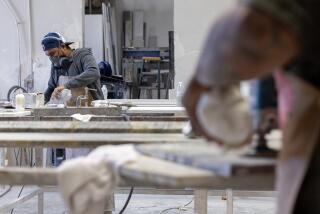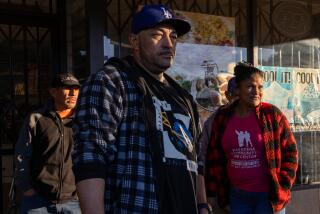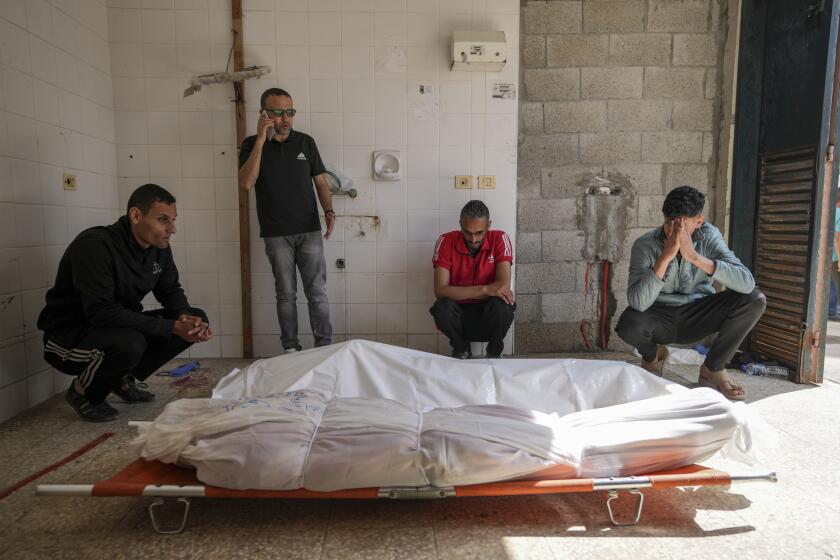For India’s bone craftsmen, the hazards abound
In a small, dark room in this city of narrow alleys and workshops the size of shoeboxes, five men in their 70s fashion combs out of water buffalo horn with hand saws for $2 a day.
“It’s very hard work,” said Abdul Bashir, 70. “But I’ve got to eat.”
Members of this predominantly Muslim community of 50,000 have hacked, chipped, cut, molded and polished animal bones and horns into baubles or beads for generations.
But the ornaments worn on the supple wrists and suntanned necks of far-off fashionistas carry a high price for these craftsmen, who must live with airborne clouds of bone dust that sticks to their eyes, hair and lungs.
“If you’re over 50 around here, you almost certainly have tuberculosis,” said Mohammad Arshad, 32, the owner of a bone-carving workshop whose parents died of the debilitating lung disease.
Although TB takes years to show up, other dangers in Sambhal, India’s unofficial bone-crafting center, appear in seconds. In one of the hundreds of small workshops, most spewing enough white dust to mimic a snowstorm, worker Mohammad Behzad sits on his haunches for 10 hours a day shaping horn pieces at an open power saw.
“If you lose your concentration for a second, you lose your finger,” Behzad said, showing several that are missing tips. “The machines are all dangerous, but the power saws are the worst.”
Child labor is another fact of life. Furqan Ali Khan, head of the Zubaida Khatoon Educational and Social Welfare Society, a local civic group, estimates that one-quarter of Sambhal’s bone and horn workers are children.
India’s laws prohibit those younger than 14 from working in “hazardous industries.” In reality, however, enforcement is spotty and inspectors look the other way with “cottage industries.” Some of those peeking from workshop doors appeared to be as young as 8.
Parents here say they’re so impoverished that they have little choice. Behzad started doing small jobs as a toddler, graduated to more complex tasks in elementary school and was a full-time bone cutter by his teens.
“We’re born to this work,” he said. “And we’ll die at it.”
During the British Empire and immediately after Indian independence, hair combs handcrafted from horn were in demand. In the mid-1960s, however, cheap plastic combs flooded the market, pushing most workers into making trinkets and low-end costume jewelry.
Muslims, a community often near the bottom of India’s social ladder, have long dominated the dirty, dangerous bone craft work. Among India’s vegetarian Hindu majority, handling animals is generally considered unclean.
Once the crafts are finished, however, non-Muslims aren’t shy about marketing the combs, jewelry, lamps and knickknacks, local workers say, garnering most of the profit. Locals say wholesalers and exporters who buy bracelets here at 5 to 10 cents turn around and sell them for as much as 100 times that in New Delhi, Berlin or New York.
“We have no contact with end buyers,” Arshad said. “Few even know our community exists.”
These mostly uneducated workers say that without the contacts, knowhow or vision required to sell their goods over the horizon, they’re largely trapped in this dusty world.
“Sambhal is definitely a place you don’t forget,” said Christopher Wolff of the World Health Organization’s polio eradication unit, who has visited several times in a bid to prevent the virus’ spread. “People working with bones in tiny workshops on such a massive scale, it’s Victorian England, one of the most challenging settings we had to work in in northern India.”
In the corners of many workshops are shoulder-high piles of bones and horns bought from slaughterhouses for 5 to 20 cents a pound. Although it’s illegal to kill cows in most Indian states, abattoirs do a thriving trade in water buffalo and oxen, with cow remains brought in from beef-eating states such as West Bengal.
At Behzad’s workshop, which specializes in making spoons and forks from oxen and buffalo horns, three men and two boys who look to be about 13 squat without safety equipment, masks or blade guards to protect their hands from the saws.
Each fork or spoon takes four hours and 21 steps to make — heating, cutting, reheating, shaping, polishing and shining — with a fork-and-spoon set selling for $1.10 to $1.90. The shop can make 200 sets a month, but some months there are no buyers.
“You can’t breathe properly just walking on these roads, and these families breathe the air 24-7,” civic group head Khan said. “Probably 99% of them are ill in one way or another.”
More to Read
Start your day right
Sign up for Essential California for news, features and recommendations from the L.A. Times and beyond in your inbox six days a week.
You may occasionally receive promotional content from the Los Angeles Times.






